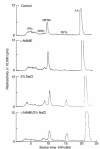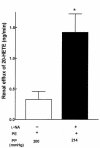Renal cytochrome P450 omega-hydroxylase and epoxygenase activity are differentially modified by nitric oxide and sodium chloride
- PMID: 10525052
- PMCID: PMC408575
- DOI: 10.1172/JCI6786
Renal cytochrome P450 omega-hydroxylase and epoxygenase activity are differentially modified by nitric oxide and sodium chloride
Abstract
Renal function is perturbed by inhibition of nitric oxide synthase (NOS). To probe the basis of this effect, we characterized the effects of nitric oxide (NO), a known suppressor of cytochrome P450 (CYP) enzymes, on metabolism of arachidonic acid (AA), the expression of omega-hydroxylase, and the efflux of 20-hydroxyeicosatetraenoic acid (20-HETE) from the isolated kidney. The capacity to convert [(14)C]AA to HETEs and epoxides (EETs) was greater in cortical microsomes than in medullary microsomes. Sodium nitroprusside (10-100 microM), an NO donor, inhibited renal microsomal conversion of [(14)C]AA to HETEs and EETs in a dose-dependent manner. 8-bromo cGMP (100 microM), the cell-permeable analogue of cGMP, did not affect conversion of [(14)C]AA. Inhibition of NOS with N(omega)-nitro-L-arginine-methyl ester (L-NAME) significantly increased conversion of [(14)C]AA to HETE and greatly increased the expression of omega-hydroxylase protein, but this treatment had only a modest effect on epoxygenase activity. L-NAME induced a 4-fold increase in renal efflux of 20-HETE, as did L-nitroarginine. Oral treatment with 2% sodium chloride (NaCl) for 7 days increased renal epoxygenase activity, both in the cortex and the medulla. In contrast, cortical omega-hydroxylase activity was reduced by treatment with 2% NaCl. Coadministration of L-NAME and 2% NaCl decreased conversion of [(14)C]AA to HETEs without affecting epoxygenase activity. Thus, inhibition of NOS increased omega-hydroxylase activity, CYP4A expression, and renal efflux of 20-HETE, whereas 2% NaCl stimulated epoxygenase activity.
Figures





Similar articles
-
Renal cytochrome p450 oxygenases and preglomerular vascular response to arachidonic acid and endothelin-1 following ischemia/reperfusion.J Pharmacol Exp Ther. 2002 Aug;302(2):717-24. doi: 10.1124/jpet.302.2.717. J Pharmacol Exp Ther. 2002. PMID: 12130736
-
Regulation of renal CYP4A expression and 20-HETE synthesis by nitric oxide in pregnant rats.Am J Physiol Renal Physiol. 2003 Aug;285(2):F295-302. doi: 10.1152/ajprenal.00065.2003. Epub 2003 Apr 8. Am J Physiol Renal Physiol. 2003. PMID: 12684227
-
Functional response of the rat kidney to inhibition of nitric oxide synthesis: role of cytochrome p450-derived arachidonate metabolites.Br J Pharmacol. 1998 Nov;125(5):1065-73. doi: 10.1038/sj.bjp.0702171. Br J Pharmacol. 1998. PMID: 9846646 Free PMC article.
-
Role of cytochrome P450-dependent arachidonic acid metabolites in liver physiology and pathophysiology.Prostaglandins Other Lipid Mediat. 2003 Oct;72(1-2):51-71. doi: 10.1016/s1098-8823(03)00077-7. Prostaglandins Other Lipid Mediat. 2003. PMID: 14626496 Review.
-
Cytochrome P-450 metabolites in renal circulation and excretion--interaction with the nitric oxide (NO) system.J Physiol Pharmacol. 2008 Dec;59 Suppl 9:137-49. J Physiol Pharmacol. 2008. PMID: 19261977 Review.
Cited by
-
Clinical Implications of 20-Hydroxyeicosatetraenoic Acid in the Kidney, Liver, Lung and Brain: An Emerging Therapeutic Target.Pharmaceutics. 2017 Feb 20;9(1):9. doi: 10.3390/pharmaceutics9010009. Pharmaceutics. 2017. PMID: 28230738 Free PMC article. Review.
-
Increased blood pressure in mice lacking cytochrome P450 2J5.FASEB J. 2008 Dec;22(12):4096-108. doi: 10.1096/fj.08-114413. Epub 2008 Aug 20. FASEB J. 2008. PMID: 18716027 Free PMC article.
-
Characterization of four new mouse cytochrome P450 enzymes of the CYP2J subfamily.Drug Metab Dispos. 2013 Apr;41(4):763-73. doi: 10.1124/dmd.112.049429. Epub 2013 Jan 11. Drug Metab Dispos. 2013. PMID: 23315644 Free PMC article.
-
Role of the adenosine(2A) receptor-epoxyeicosatrienoic acid pathway in the development of salt-sensitive hypertension.Prostaglandins Other Lipid Mediat. 2012 Aug;98(3-4):39-47. doi: 10.1016/j.prostaglandins.2011.12.002. Epub 2011 Dec 22. Prostaglandins Other Lipid Mediat. 2012. PMID: 22227265 Free PMC article. Review.
-
Role of 20-HETE in the antihypertensive effect of transfer of chromosome 5 from Brown Norway to Dahl salt-sensitive rats.Am J Physiol Regul Integr Comp Physiol. 2012 May 15;302(10):R1209-18. doi: 10.1152/ajpregu.00604.2011. Epub 2012 Mar 21. Am J Physiol Regul Integr Comp Physiol. 2012. PMID: 22442195 Free PMC article.
References
-
- Moncada S, Palmer RMG, Higgs EA. Nitric oxide: physiology, pathophysiology and pharmacology. Pharmacol Rev. 1991;43:109–142. - PubMed
-
- Nathan C. Nitric oxide is a secretory product of mammalian cells. FASEB J. 1992;6:3051–3064. - PubMed
-
- Hurshman AR, Marletta MA. Nitric oxide complexes of inducible nitric oxide synthase: spectral characterization and effects on catalytic activity. Biochemistry. 1995;34:5627–5634. - PubMed
-
- Griscavage JM, Habbs AJ, Ignarro LJ. Negative modulation of nitric oxide synthase by nitric oxide and nitroso compounds. Adv Pharmacol. 1995;34:215–234. - PubMed

